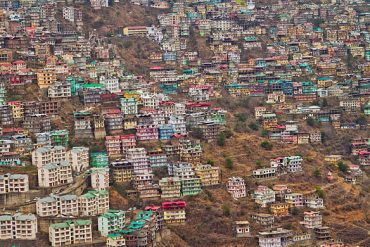Mumbai (IANS) Few know about Indira Niwas, a ramshackle two-storeyed chawl almost a century old, precariously standing on a busy main road in the Kurla suburb of northeast Mumbai.
Local residents suspiciously guide you to the dilapidated structure housing many separate tenements, where a rickety staircase leads to a bare clinic on the first floor. There, Sainath Gawankar, 64, a simple, down-to-earth doctor, receives you with a generous smile and a warm handshake, instantly making you feel at ease.
In a room adjoining the clinic, lies Gawankar’s secret family treasure – an original ‘kafni’ (kurta) purportedly worn by one of India’s most revered saints, the Sai Baba of Shirdi, over a century ago. Gawankar ushers you into the small room, barely 120 square feet, with an 80 square foot kitchen attached, with just one tube light. However, the winter sunlight showers sufficient light to view the treasure inside.
“It was gifted by Sai Baba to my father, Keshav B. Gawankar, when he was just 12 years old, in Shirdi. It was in 1918, a few months before Baba attained ‘samadhi’ and became immortal,” Gawankar tells proudly, as you stare in awe at the relic, flanked by a large painting of Sai Baba and two pictures of his father on opposite walls.
Born on April 28, 1906, in Arnala fishing village of Vasai, around 40 km northwest of Mumbai, when Keshav was seven years old, he suffered from acute pain in the chest and fever. In those days, there were no medications except for surgery, says Gawankar.
A neighbor, Yeshwantrao Galwankar, who was a devotee of Sai Baba, advised the distraught family to repose faith in the famous saint of Shirdi and await his ‘leela’ (miracle). Keshav’s aunt, Thamabai, vowed that if he was cured, she would offer a packet of pedhas to Sai Baba.
The very next day, Keshav was miraculously cured and continued with his studies in a Marathi school.
Exactly 95 years ago, in January 1918, the family finally travelled to Shirdi. Aunt Thamabai offered the promised pedhas to Sai Baba. He removed six pedhas from the box and gave them to Keshav, the rest he started eating.
When a devotee, Madhavrao Deshpande alias Shama, jocularly commented on this ‘selfishness’, Sai Baba pointed at the embarassed aunt and mischievously said: “She kept me hungry for five years..!”, and continued enjoying the sweet offering.
Then, Sai Baba made the 12-year old Keshav sit next to him, and a divine bond seemed to develop between them. Sai Baba removed the kurta he was wearing and offered it to the bewildered boy, who grew up to became a doctor.
Made of white cotton, the kurta has become pale yellow over a century after it was stitched. Until 1993, it was kept carefully folded in a wooden box. Later, Gawankar brought it out and kept it on a hanger inside a wood-framed glass cupboard for regular ‘darshan’.
“We open it for soft cleaning for a couple of hours only on Dussehra Day. It has become frail over the years. We don’t allow anybody to even touch it. Very few, may be a couple of hundred devotees who knew about this gift to my father, come for ‘darshan’ annually,” Gawankar said.
Years after his ‘samadhi’, Gawankar claims that Sai Baba came to the same Indira Niwas and spent hours speaking with father Keshav, on Jan. 18, 1954.
“I was only five years old at the time, but the entire family clearly remembers the divine image of Sai Baba sitting here. He and my father engaged in a long conversation. I could see them as they sat in the verandah from 10.30 pm to 8.30 am the next morning,” Gawankar says, pointing to the exact spot, 59 years later.
Around a decade later, one night when Keshav was in deep sleep, he heard a soft voice saying: “Come on…Get up and write my stories.”
Still groggy, Keshav rose, recognized the voice of Sai Baba, said a prayer to him, picked up a pen and note-pad and furiously started writing.
Starting at 1.30 am and ending at 10 am that morning, Keshav completed a majority of the chapters of the book, later published as a Marathi bestseller, “Shirdiche Sai Baba.” In 2011, Gawankar translated it in English to address a larger audience of devotees.
Keshav Gawankar died peacefully on June 29, 1985, aged 79, in the same house in Kurla, blessed by Sai Baba’s divine visit.
Certain ceremonies and rituals like Aradhana Vidhi on Sai Baba’s ‘punyathithi’ or death anniversary, are carried out annually in Sai Baba’s memory in Kurla. This ritual is performed only at Kurla and Shirdi.
When asked how the kurta is kept in such a casual fashion, Gawankar smiled: “Nobody will try to steal or take away this treasure from us. They could face Sai Baba’s wrath.”
Gawankar, wife Asmita and son Dnyanesh say their main concern is not the safety of the treasure but the dilapidated structure where it is kept.
“This building is on its last legs. Despite our best efforts, the local BrihanMumbai Municipal Corporation, in connivance with the landlord, have denied permission to carry out basic repairs,” Gawankar lamented.
Asmita, 57, and Dnyanesh, 31, say that even the annual Dussehra and Ekadasi rituals are becoming dangerous in view of the shaky structure with increasing number of devotees, including foreigners, who throng to see it.
“So far, Sai Baba’s blessing has kept this structure from collapsing. But for how long? If there is any major disaster, the civic authorities will have to answer for their negligence,” Dnyanesh, a third-generation medico in the Gawankar family, complained.
The opinions, beliefs and viewpoints expressed by authors, news service providers on this page do not necessarily reflect the opinions, beliefs and viewpoints of Hill Post. Any views or opinions are not intended to malign any religion, ethnic group, club, organization, company, or individual.
Hill Post makes no representations as to the accuracy or completeness of any information on this site page.



